Allium Flower Care and Growing Tips
Updated: May 15, 2024
Alliums are easy to plant in fall and enjoy in spring. Check out our care tips for growing alliums and our favorite allium flower varieties.
On This Page
How to Grow Allium Flowers

- Allium hybrid
- Zones: 4 to 8
- Attracts: bees and butterflies
- Light needs: Part sun to full sun
- Soil: Well-draining
- Cultivars to try: Medusa, Summer Beauty and Summer Peek-a-Boo alliums are worth checking out.
It’s impossible to quickly summarize allium flowers, a gigantic group of perennial, edible and ornamental plants with different sizes, shapes, colors and bloom times. But it’s easy to sing their praises.
Alliums, members of the onion family with about 1,000 species, grow in most climates and have bloom times from early spring through fall and later in mild climates. Most are drought resistant and grow best in full sun, although some tolerate shade.
They can tolerate hot summer weather, with long-lasting blooms that attract butterflies. Plus, deer and rabbits tend to leave alliums alone.
“They’re durable, long-lived, trouble-free for the most part, and deer resistant,” says Brent Horvath, president of Intrinsic Perennial Gardens in Hebron, Illinois, who selects and breeds alliums and other perennials. “They’re up-and-coming in popularity, too.”
Two main types of alliums—bulbs and clump-forming—each have their own characteristics. If you plan carefully, it’s possible to have an allium blooming from early spring to late in the year.
Garden tip—you may need to learn to be comfortable with botanical Latin because many alliums don’t carry a consistent common name.
When to Plant Allium Flower Bulbs
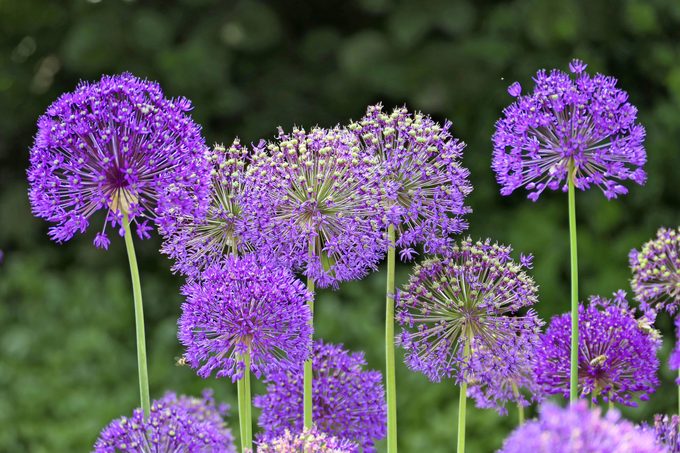
Because allium bulbs need a cold dormant period to flower, they must be planted in the fall. They shoot up in spring, flower, dry up and then go dormant. Bulbs may rot in wet poor-draining soils, so consider planting them in rock gardens or soils that don’t retain water.
Many gardeners are familiar with spring-flowering allium bulbs, especially the attention-grabbing big ball types, such as Globemaster, Gladiator, Purple Sensation and the showstopping 8-inch-wide flower head of Allium giganteum.
Other bulb favorites include fireworks-shaped alliums such as tumbleweed allium (A. schubertii) or Star of Persia (A. cristophii); low-growing Turkestan onion, such as Ivory Queen (A. karataviense); and drumstick alliums with slender stalks and elongated small flower heads that resemble a drumstick.
Check out the top 10 biggest blooms for your flower garden.
Clump-Forming Allium Flowers
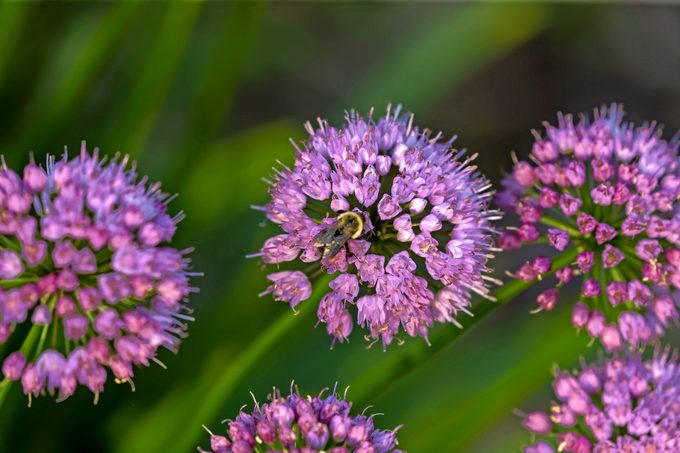
This type of allium flower grows from tiny bulbs or fibrous roots attached to underground stems called rhizomes. These alliums, such as common chives, parade their blooms after spring and can be planted from spring to fall. They tolerate soils that retain more water.
Their lively foliage adds texture to a garden. Some have twisted or curly leaves while others are straplike. Leaf colors vary from bright Kelly green to gray-blue.
Millenium allium, selected as the 2018 Perennial Plant of the Year by the Perennial Plant Association, is a clumping type with 10-to-15-inch deep-green leaves. Each 2-inch-wide rosy purple spherical puff contains dozens of tiny individual flowers that become pollinator magnets. It will add jolts of color and texture to your summer garden. This hybrid genus doesn’t self-seed, so you won’t have unwanted volunteers.
Allium Flower Landscaping Tips
Alliums work well in many garden settings. Brent is particularly fond of clump-forming alliums. “They’re increasing in popularity, and they’re great foliage plants,” he says. He mixes two or more types in different sizes and colors. His breeding produced 18-inch-tall Windy City, with violet-colored flowers, which he pairs with 10-inch-tall Summer Beauty, sporting lavender flowers on stems up to 20 inches tall.
The Lurie Garden in Chicago uses Summer Beauty in mass plantings. “It’s hard to beat for foliage, and it looks good from the time it emerges in April to the end of the year,” Brent says.
Clumping types easily fill spaces in the front or middle of a perennial and shrub border.
Allium bulb leaves often begin to die even before the blooms open, so interplant bulbs with other perennials to hide the unsightly foliage. Once the bloom fades, consider leaving the remaining brown stalk and flower head intact to add unusual texture.
More simple tips for alliums:
- Grow in full sun for bigger blooms, stronger stems and more reliable flowers.
- Plant in well-draining soil to avoid bulb rot.
- After flowering, keep foliage intact to allow the bulb to recharge for next season.
Check out more purple flowers to grow in your garden.
Top 10 Allium Flowers to Grow
Globemaster
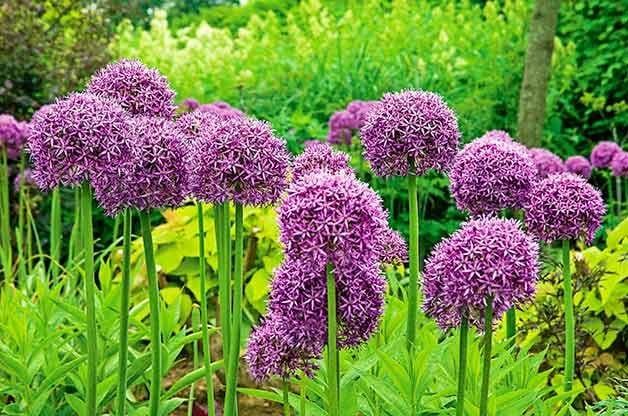
Allium ‘Globemaster’, Zones 4 to 8
A hybrid cross between two species, Globemaster is considered one of the best and most beloved of the tall spring-blooming types. Purple spheres covered with hundreds of individual florets grow 8 to 10 inches wide, and look fabulous in a vase. Look for bigger bulbs for larger flowers.
Why we love it: The sturdy 2- to 3-foot stems add vertical interest, and stand up to wind and rain.
Ambassador
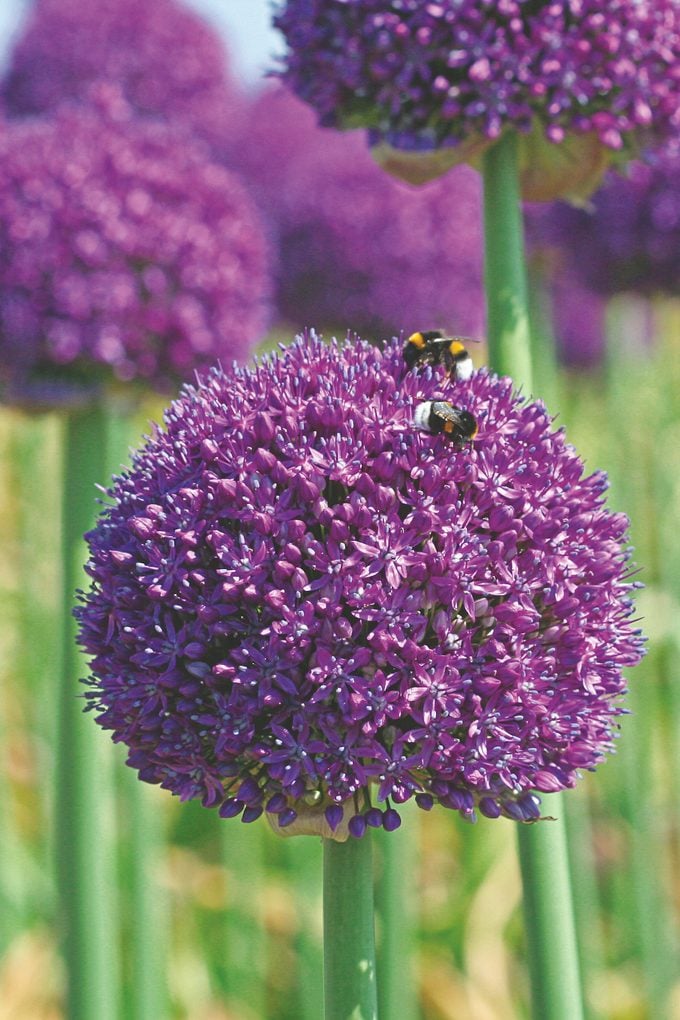
Allium ‘Ambassador,’ Zones 4 to 8
Many spring-blooming alliums bear similar mug shots, but they all behave differently. Ambassador is one of the tallest, at 3 to 4 feet, with 7-inch, rich purple globes. Plant a few varieties of alliums that bloom in succession for continual blooms. Foliage tips tend to turn brown before the flowers open.
Why we love it: It attracts bees and other pollinators during its long five-week bloom period.
Persian Shallot
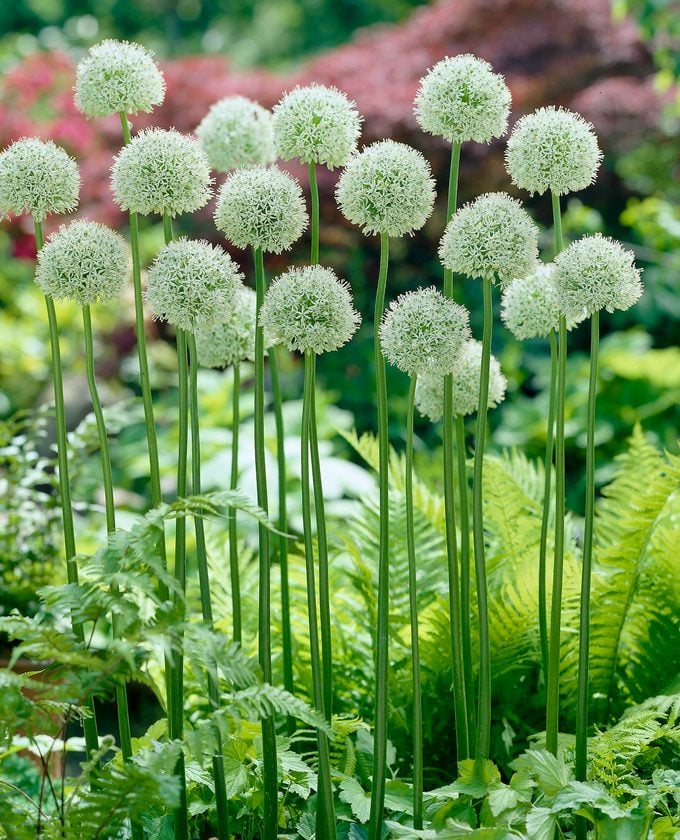
Allium stipitatum ‘White Giant,’ ‘Mount Everest’, Zones 4 to 8
For white counterparts that look stunning planted near the tall purple spring-blooming types, check out White Giant, which grows 3 to 4 feet tall with 6- to 8-inch-wide flower clusters, or Mount Everest, with 36-inch-tall stems with 4-inch-wide blooms.
Why we love it: Bright white bloom clusters resemble fluffy snowballs on stems. Use these beauties to add a whimsical twist to arrangements.
Millenium
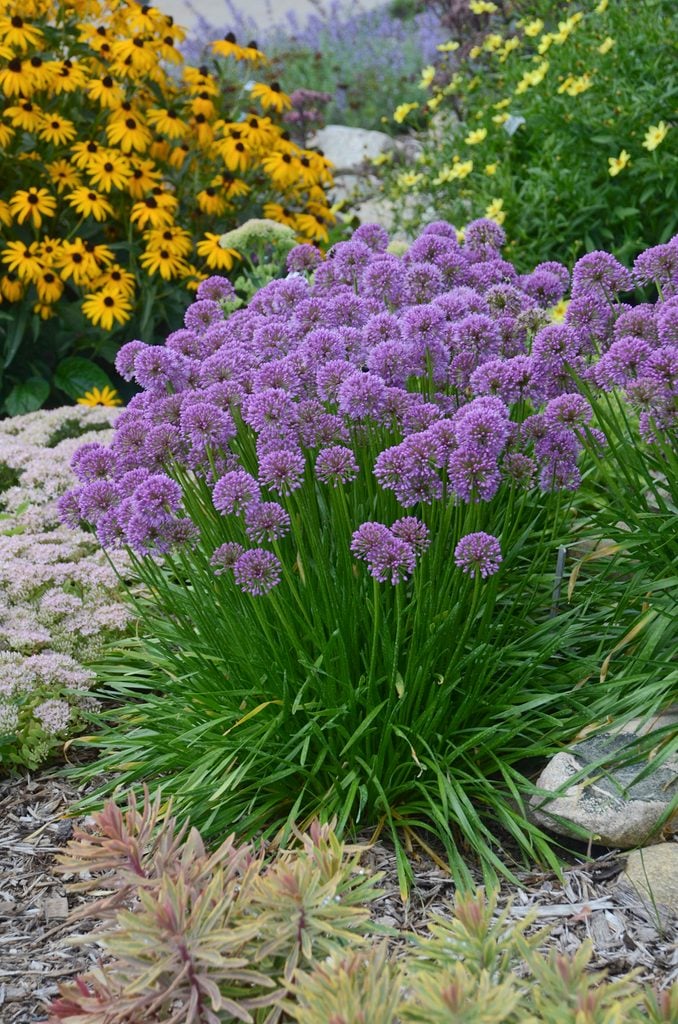
Allium ‘Millenium’, Zones 4 to 8
Low-maintenance Millenium alliums feature dozens of fragrant, deep pink, spherical flowers that bloom from mid to late summer. The foliage is thin, glossy and dark green in color. Plant them 10 to 15 inches apart and divide the fibrous root system in spring or fall.
Its rosy purple globes are just 2 inches wide, and its low stature makes it easy to tuck into almost any garden.
Why we love it: This award winner was dubbed 2018 Perennial Plant of the Year by the Perennial Plant Association.
Fireworks
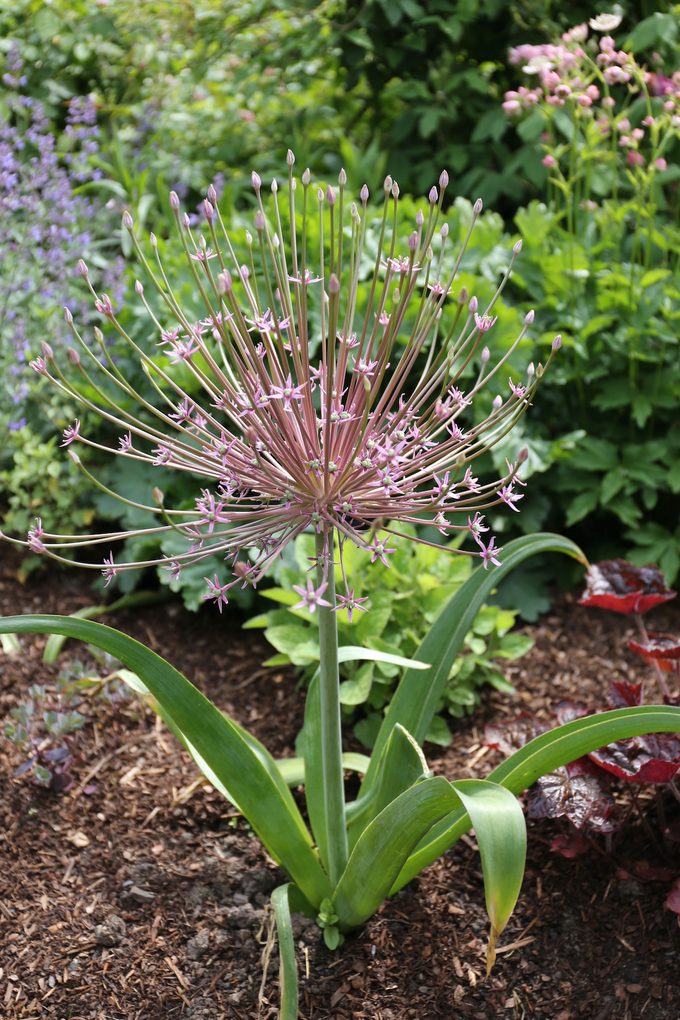
Allium schubertii, Zones 4 to 8
This allium explodes like fireworks with a wispy 9- to 12-inch-wide round, rosy purple bloom cluster composed of 50 to 100 shooting florets. The entire flower head falls off the stem when it dries out, rolling and scattering seeds in the wind like a tumbleweed—the reason it’s sometimes called a tumbleweed onion.
Why we love it: Use the dried flower heads and stems in arrangements; you can even spray-paint them for more color!
Yellow-Flowered Garlic
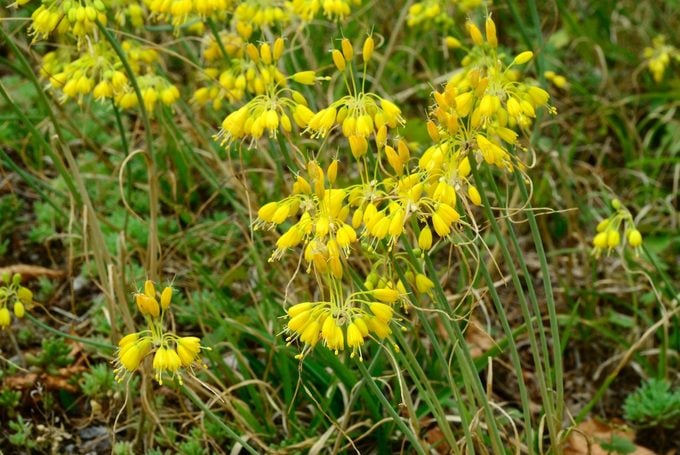
Allium Flavum, Zones 4 to 8
It’s not a common sight in American gardens, but this delicate allium is an easy plant to grow for late spring and early summer. Fragrant yellow umbels perch on wiry, thin stems above blue-green leaves. Remember where it’s planted; until it flowers the slender leaves may resemble grasses.
Why we love it: This bulb will naturalize in locations where it’s doing well, creating a patch of lemon yellow flowers.
Ivory Queen
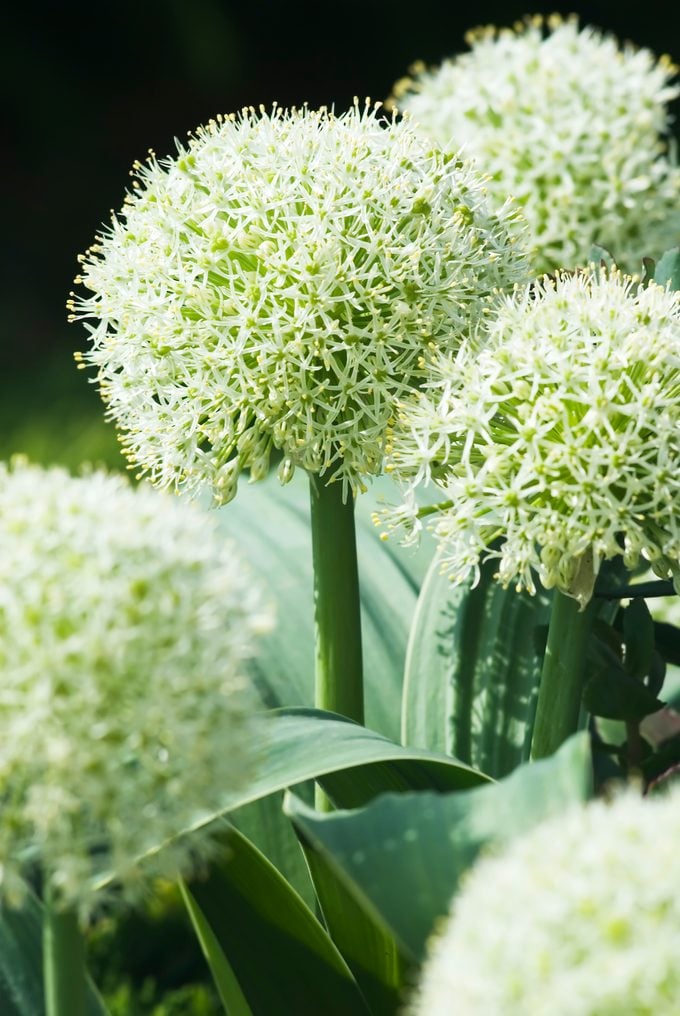
Allium karataviense ‘Ivory Queen’, Zones 4 to 8
Ivory Queen is a great front-of-the-border allium with thick bluish green leaves that are almost as attractive as the 3-inch white globes above it. If you can’t find this cultivar, stick to the straight species, which has pale pink umbels instead of snowy white.
Why we love it: Less stem means more flower power closer to the ground.
Star of Persia
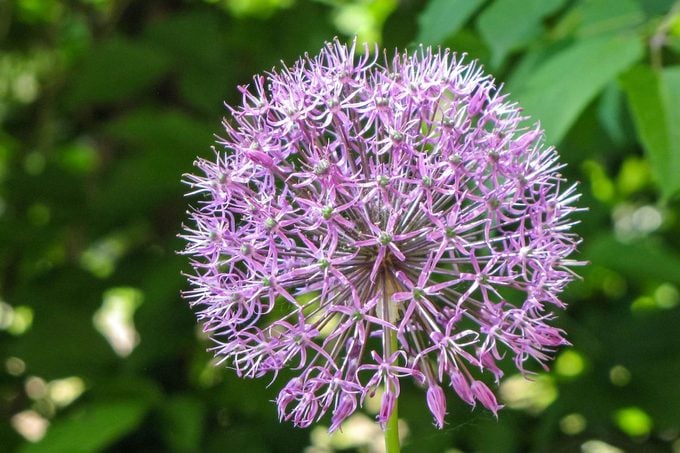
Allium cristophii, Zones 4 to 8
This plant’s name provides a hint about its origin—the dry soils of ancient Iran. The amethyst-pink florets are larger than those of many other varieties of alliums. It’s good for rock gardens, and is an ideal short border plant.
Why we love it: The florets have a silvery sheen, so the 8- to 10-inch-wide spherical flower seems to sparkle.
Drumstick
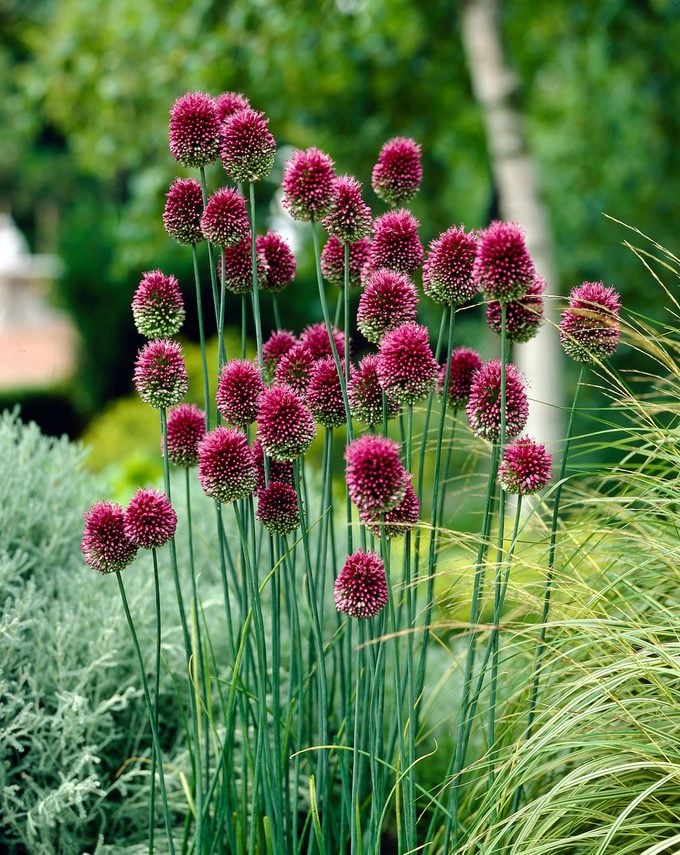
Allium sphaerocephalon, Zones 4 to 8
It’s hard to say just how the drumstick allium got its common name— it does not really resemble either a chicken drumstick or the instrument used for drumming. This early summer bloomer may resemble a slender grass until the 1-inch-wide, egg-shaped composite flowers start blooming in midsummer.
Why we love it: The clusters look like hefty and colorful clovers, with bicolor florets that change from green to purple.
Blue Globe Onion
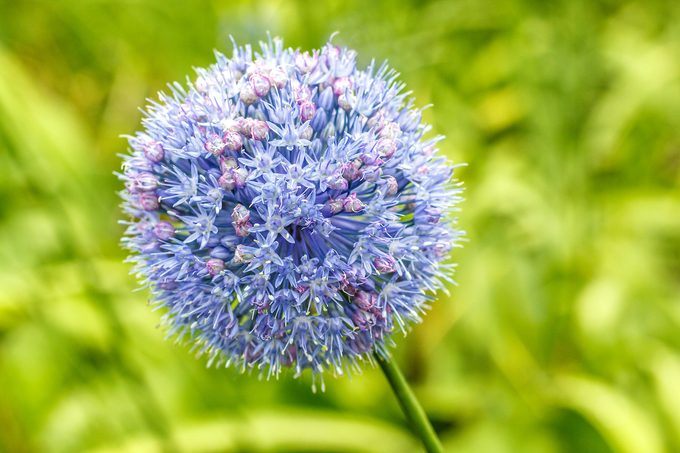
Allium caeruleum, Zones 4 to 8
Try to remember where you’ve planted blue globe onion. Slender leaves clinging to wiry stems may resemble grasses or garden chives until they’ve fully matured. The 1-inch-wide umbels open to reveal a surprise bouquet of cornflower blue florets.
Why we love it: That cool blue color! And butterflies love it, too.
More Unique Allium Varieties
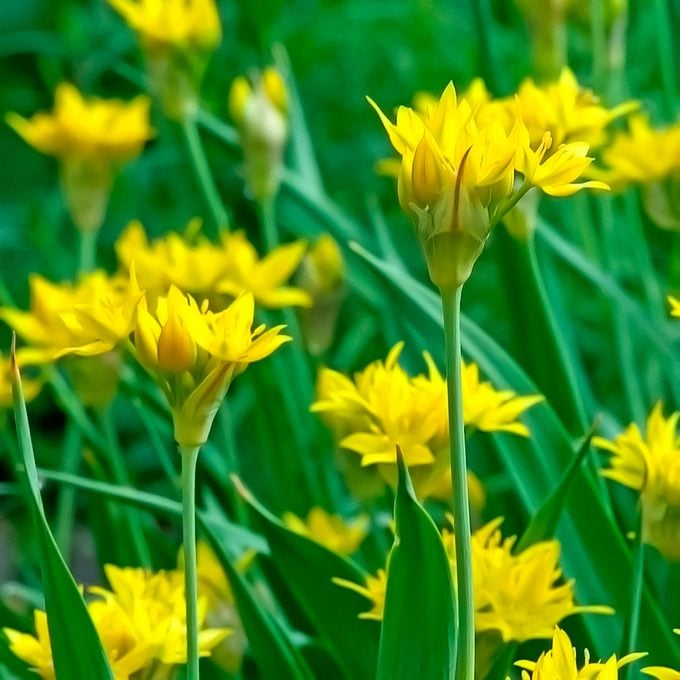
Also look for alliums with unusual forms or colors. One of the weirdest is Hair, which has tiny frizzy green blooms that make it look as if it’s having a bad hair day; it reseeds readily. Allium bulgaricum, a Mediterranean native that goes by several botanical names, carries drooping florets that spray out attractively from the central stem. At over 3 feet tall, it makes a statement.
Add yellow with varieties of Allium moly, which has late-spring-to-early-summer loose yellow flowers and foot- tall foliage; it self-seeds too.
True blue, an unusual garden color, shows off with Allium caeruleum (also called A. azureum) and the delicate blue of Allium caesium.
Allium Flower Growing Restrictions
Gardeners in parts of Idaho and Oregon cannot buy alliums grown outside of their quarantined regions because of a need to prevent a fungal onion disease known as white rot. The disease threatens the region’s extensive commercial onion crop because it can live in the soil for up to 30 years. Only seeds and locally produced bulbs can be grown in those areas.
About the Experts
Brent Horvath is a plant breeder and the president of Intrinsic Perennial Gardens. He earned a degree in ornamental horticulture from Oregon State University.






















